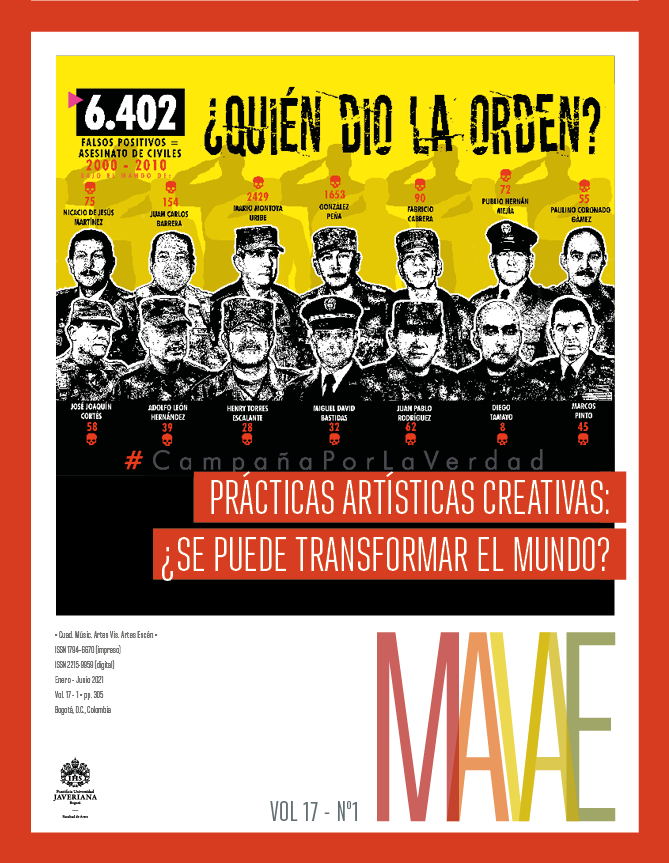Resumen
Desde el 18 de octubre de 2019 “Chile cambió”, mediante un efervescente estallido social que puso en la palestra las desigualdades del sistema político, económico y social que por años ha sumido a la mayoría de la población a una vida sin bienestar. Tras dicho “estallido”, el Gobierno declaró el estado de excepción de la mano de una violencia estatal no vista desde la última dictadura, que disparó en la memoria colectiva imágenes de nuestro pasado reciente y nos violentó física y simbólicamente. Una irrupción en el campo de lo mnemotécnico que puso de manifiesto las relaciones abiertas entre pasado y presente, e hizo patente nuestras formas de resistencia y sus continuidades. Así como en la autarquía diversas mujeres artistas y ciudadanas pusieron en escena sus cuerpas mediante valientes y creativas acciones que evidenciaron la violencia impuesta, hoy otras prácticas artísticas y estético-políticas vuelven a colocar la cuerpa en el espacio público para imaginar una vida que sea vivible. Con ellas, con sus acciones y prácticas artísticas, transitamos por algunas obras de arte, acciones y performances que en su praxis social nos acercan a los desafíos actuales en defensa de la vida. Obras que invocan esa otra escritura de la historia para crear no solo nuevas formas de hacer y narrar nuestras corporalidades y subjetividades fracturadas, sino también articular y potenciar desde lo colectivo nuestras memorias y resistencias para transformar el/nuestro mundo.
Agamben, Giorgio. 2005. Estado de Excepción (homo sacer II, 1). Buenos Aires: Adriana Hidalgo.
Arendt, Hannah. 1990. Hombres en tiempos de oscuridad. Barcelona: Gedisa.
Arendt, Hannah. 2014. Sobre la violencia. Madrid: Alianza.
Benjamin, Walter. 2008. “Sobre el concepto de Historia”. En Obra completa. Libro I/vol. 2. Madrid: Abada.
Berardi, Franco. 2014. La sublevación. Buenos Aires: Hekht.
Berger, John. 2013. Mirar. Barcelona: Gustavo Gili.
Bourdieu, Pierre. 1999. Razones prácticas: Sobre la teoría de la acción. Barcelona: Anagrama.
Butler, Judith. 2017. Cuerpos aliados y lucha política: Hacia una teoría performativa de la asamblea. Buenos Aires: Paidós.
Carvajal, Fernanda, André Mesquita y Jaime Vindel, eds. 2012. Perder la forma humana: Una imagen sísmica de los años ochenta en América Latina. Madrid: Museo Nacional Centro de Arte Reina Sofía.
Castillo, Alejandra. 2019. Asamblea de los cuerpos. Santiago de Chile: Sangría
Cepal (Comisión Económica para América Latina y el Caribe). 2017. “Panorama social de América Latina 2017”. https://www.cepal.org/es/publicaciones/42716-panorama-social-america-latina-2017.
Civicus. 2020. “‘Chile ha privatizado por completo el agua, lo cual significa que el robo está institucionalizado’”. https://www.civicus.org/index.php/es/medios-y-recursos/noticias/entrevistas/4270-chile-ha-privatizado-porcompleto-el-agua-lo-cual-significa-que-el-robo-esta-institucionalizado
Diario Uchile. 2019. “Hospitales en crisis: Profesionales denuncian condiciones deplorables en Valparaíso”, 18 de octubre. https://radio.uchile.cl/2019/10/18/hospitales-en-crisis-profesionales-denunciancondiciones-deplorables-en-valparaiso/.
Didi-Huberman, Georges. 2013. Cuando las imágenes tocan lo real. Madrid: Círculo de Bellas Artes.
Di Girolamo, Greta. 2019. “Capuchas feministas a la chilena”. VICE, 17 de diciembre. https://www.vice.com/es_latam/article/5dmmn8/capuchas-feministas-a-la-chilena.
El Arrebato. 2019. “Violadores: La intervención de la ‘Yeguada Latinoamericana’ que interpeló a Carabineros”, 1 de noviembre. https://www.elarrebato.cl/2019/11/01/fotos-violadores-la-intervencion-de-layeguada-latinoamericanaque-interpelo-a-carabineros/?fbclid=IwAR0GwjLxHFNQK5ZJ2dT0Ja9bJAr0tsWb1lub4uOxbyzbnddF70EFeePES08.
Eldesconcierto.cl. 2018. “El grito de Cheril Linett, la artista que sacó a la yeguada latinoamericana a denunciar la violencia a la calle”. https://www.eldesconcierto.cl/tendencias/2018/11/09/el-grito-de-cherillinett-la-artista-que-saco-a-la-yeguada-latinoamericana-a-denunciarla-violencia-a-la-calle.html.
Fiscalía de Chile. 2020. “Fiscalía eleva a 5.558 las víctimas que denuncian violaciones a Derechos Humanos desde el inicio de las manifestaciones sociales”. http://www.fiscaliadechile.cl/Fiscalia/sala_prensa/noticias_det.do?id=17285
Freund, Gisèle. 2017. La fotografía como documento social. Barcelona: Gustavo Gili.
Galtung, Johan. 1998. Tras la violencia, 3R: Reconstrucción, reconciliación, resolución. Afrontando los efectos visibles e
invisibles de la guerra y la violencia. Bilbao: Bakeas. https://www.gernikagogoratuz.org/wp-content/uploads/2020/05/
RG06completo.pdf.
Gros, Fréderic. 2018. Desobedecer. Barcelona: Taurus.
Groys, Boris. 2016. Volverse público: Las transformaciones del arte en el ágora contemporánea. Buenos Aires: Caja Negra.
Holmes, Brian. 2007. Investigaciones extradisciplinares: Hacia una nueva crítica de las instituciones. Transversal texts. https://
transversal.at/transversal/0106/holmes/es?hl=holmes.
INDH (Instituto Nacional de Derechos Humanos). 2020. “Reporte general de datos sobre violaciones a los derechos humanos Datos desde 17 de octubre de 2019 e ingresados hasta el 13 de marzode 2020”. https://www.indh.cl.
Inventario Iconoclasta de la Insurrección Chilena. 2021. “Acerca del proyecto”. http://inventarioiconoclastadelainsurreccionchilena.com/.
Lakoff, Robin. 1973. “Language and Woman’s Place”. Language in Society 2, n.º 1: 45-79. https://doi.org/10.1017/S0047404500000051.
Martínez-Pacheco, Agustín. 2016. “La violencia: Conceptualización y elementos para su estudio”. Política y Cultura, n.º 46: 7-31.
https://polcul.xoc.uam.mx/index.php/polcul/article/view/1300.
Morandé, Josefina, dir. 2018. Hoy y no mañana. https://miradoc.cl/hoyy-no-manana/.
Paúl, Fernanda. 2019. “Protestas en Chile: 4 claves para entender la furia y el estallido social en el país sudamericano”. BBC News,
de octubre. https://www.bbc.com/mundo/noticias-americalatina-50115798
Posada, Diego y Lior Zisman Zalis. 2019. “Retórica para-fascistas y sus contra-imágenes: Una cartografía crítica”. Re-visiones, n.º 9. http://www.re-visiones.net/index.php/RE-VISIONES/article/view/348.
Rojas, Sergio. 2020. “Violencia”. https://contraelestadodeexcepcion.uchilefau.cl/violencia/
Rolnik, Suely. 2019. Esferas de la insurrección: Apuntes para descolonizar el inconsciente. Buenos Aires: Tinta Limón.
Sabato, Ernesto. 2000. La resistencia. Buenos Aires: Seix Barral.
Segato, Rita. 2016. La guerra contra las mujeres. Buenos Aires: Prometeo.
Taylor, Diana. 2015. Performance. Buenos Aires: Asunto Impreso.
Trienal Internacional de Performance Deformes. 2020. “Nuestra trayectoria”. https://performancedeformes.cl/index.php?inicio
Varas, Paulina E. 2018. Luz Donoso: El arte y la acción en el presente. Santiago de Chile: Ocho Libros.

Esta obra está bajo una licencia internacional Creative Commons Atribución 4.0.
Derechos de autor 2021 Viviana Silva Flores



